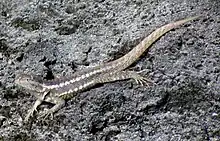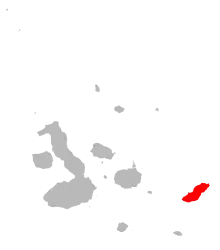| San Cristóbal lava lizard | |
|---|---|
 | |
| Male | |
| Scientific classification | |
| Domain: | Eukaryota |
| Kingdom: | Animalia |
| Phylum: | Chordata |
| Class: | Reptilia |
| Order: | Squamata |
| Suborder: | Iguania |
| Family: | Tropiduridae |
| Genus: | Microlophus |
| Species: | M. bivittatus |
| Binomial name | |
| Microlophus bivittatus (Peters, 1871) | |
 | |
| Synonyms[2] | |
| |
Microlophus bivittatus, the San Cristóbal lava lizard, is a species of lava lizard endemic to San Cristóbal Island in the Galápagos Islands.[1][2][3] The species is commonly attributed to the genus Microlophus but has been attributed to the genus Tropidurus.[2] They are currently under threat by invasive cats on the island.[1][4] The lizard is also closely related to the Microlophus occipitalis which radiated off of the bivittatus.[5]
Reproduction
Lava lizards have a breeding ritual where males will compete via head bobbing to avoid physical conflict. Research has found that head bobbing achieves a greater response when the response is immediate as compared to a 30-second delay.[6] Larger males will receive greater aggression from other males and greater assertive responses from females.[7] There is no current data that supports ecological competition is higher between same sex individuals however.[8]
References
- 1 2 3 Márquez, C.; Cisneros-Heredia, D.F. (2016). "Microlophus bivittatus". IUCN Red List of Threatened Species. 2016: e.T48444538A48444597. doi:10.2305/IUCN.UK.2016-1.RLTS.T48444538A48444597.en. Retrieved 20 November 2021.
- 1 2 3 Microlophus bivittatus at the Reptarium.cz Reptile Database. Accessed 11 February 2021.
- ↑ Benavides, Edgar; Baum, Rebecca; Snell, Heidi M.; Snell, Howard L. & Sites, Jr., Jack W. (June 2009). "Island biogeography of Galápagos lava lizards (Tropiduridae: Microlophus): species diversity and colonization of the archipelago" (PDF). Evolution. 63 (6): 1606–1626. doi:10.1111/j.1558-5646.2009.00617.x. JSTOR 40306236. PMID 19154379. Archived from the original (PDF) on 2013-09-21.
- ↑ Carrió n, Paola L. & Valle, Carlos A. (2018-05-01). "The diet of introduced cats on San Cristobal Island, Galapagos: cat feces as a proxy for cat predation". Mammalian Biology. 90: 74–77. doi:10.1016/j.mambio.2018.02.004.
- ↑ Koenig, Meghan (2017-05-12). "The relationship between sex and territorial behavior in the San Cristóbal lava lizard (Microlophus bivittatus)". All College Thesis Program, 2016-2019.
- ↑ Clark, David L.; Macedonia, Joseph M.; Rowe, John W.; Austin, Michaela R.; Centurione, Isabella M. & Valle, Carlos A. (2019-09-05). "Galápagos lava lizards (Microlophus bivittatus) respond dynamically to displays from interactive conspecific robots". Behavioral Ecology and Sociobiology. 73 (10): 136. doi:10.1007/s00265-019-2732-6. S2CID 201834524.
- ↑ Mancero De La Torre, Emilio José (2018). Role of Microlophus bivittatus body size in sexual selection: behavior analysis by lizard robot displays (Licenciado en Biología thesis). Universidad San Francisco de Quito.
- ↑ Koenig, Meghan (2017-05-12). The relationship between sex and territorial behavior in the San Cristóbal lava lizard (Microlophus bivittatus) (thesis). All College Thesis Program, 2016–2019. Vol. 32. College of Saint Benedict/Saint John's University.
